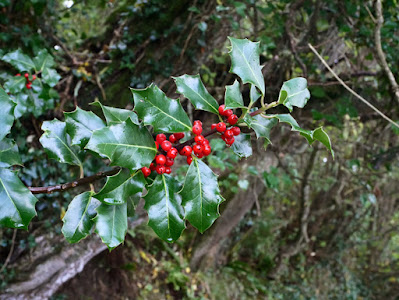When looking through the botanical records for Cornwall's estuaries, I noticed that in many places the only species of Glasswort recorded was Common Glasswort, and even then, mostly as an aggregate. In other words, it would be worth surveying my local estuaries more thoroughly to see what Glassworts I might find.
My trips showed me that Common Glasswort (Salicornia europaea) was indeed the most common species, but along the way I also found a few other species. The Hayle Estuary in the west of the county had been well recorded and was the most diverse in terms of Salicornias, so I concentrated elsewhere.
I visited the Camel Estuary in a few places and also a tributary or two of the Truro River. One place I found none at all was the River Fal, up near Lostwishiel. The habitat seemed wrong, with little shallow saltmarsh and oozing loose mudflats.
As expected, I found plenty of Common Glasswort, but it didn't take long to find some very red plants. Close examination of the plants showed these to be Purple Glasswort. Sometimes, Common Glasswort can also turn somewhat purple, so you have to be careful in determining the species. Much like Common Glasswort, it has beaded sections and smaller side flowers than the main central one, however, there is a wide (2mm) scarious margin along the pointed part of the leaf edge. This is almost invisible in Common Glasswort, thus this and the colour are used to determine them.
Salicornia ramosissima
Below is Common Glasswort to show the differences. It is nearly always green, but as it ages may turn yellow or purple. I have noticed that mostly only parts of the plants change colour, the majority stays a pale to mid green, dull and not shiny (unless wet).
Salicornia europaea
Below is the yellow form of Common Glasswort.
Note the smaller side flowers. In Yellow Glasswort, all three flowers are equal in size. Look at several flowers to get an average on a plant. Also note that the side branches lack woody stems and grow directly out of the main stem.
Below is Long-stalked Glasswort. This plant is very distinctive having very long stems, and lacks the bumpy beady segments that characterises Common Glasswort. Previously these were only known in the Hayle Estuary and were a recent arrival there in the last ten years or so (Cornwall Flora). It seems they are spreading then, as I found them in the Camel estuary in several locations up the river. Of course, it could be that previous recorders recorded them as Common Glasswort aggregate without a closer examination of the plants. So it can't be known for sure how long they have been in the estuary.
Salicornia dolichostachya
With Long-stalked Glasswort, the stems are regular without obviously beaded sections and no other Glasswort has such long sections. All three flowers are roughly of equal size. They are found mostly in the lower parts of the saltmarsh and are often the last vegetation found in such habitats. A young plant could be confused with Yellow Glasswort, which is similar but has much smaller stems and fewer sections. All branches on Yellow Glasswort are stalked too.
Lower parts of the saltmarsh and Salicornia dolichostachya in the foreground at Dinham Creek, Camel Estuary.
Salicornia dolichostachya and Salicornia ramosissima growing together at Halwyn, Camel Estuary.
A search of the Gannel estuary, just south of Newquay revealed a long lost small colony of Yellow Glasswort. This is very rare in Cornwall, so it was great to find it again. It was last found on 24/Oct/1911 in the Gannel by Dr Vigurs, a famous botanist of the time. I also found this plant in the Camel Estuary, though only a single plant. The flowers and cylindrical form of Yellow Glasswort is very similar to Long-stalked Glasswort, but note how much smaller the stems are, with all side branches stalked too.The three flowers are of a more or less equal size too with no scarious margins to the segments.
Salicornia fragilis
The grassy area below which is submerged regularly by tides is a typical Common Glasswort habitat, here at St John's near Torpoint.
Luckily, I was quite familiar with all these Glassworts as they are much commoner in Kent where I used to live. The Kent Botanical Recording Group also had a Salicornia field trip every late Summer to help recorders identify them. This helped me so much, so check out your local botany group and see if they have such field trips.
I've yet to find other glasswort species in Cornwall and there are a few more species that could turn up. They include, One-flowered Glasswort, Shiny Glasswort, and Perennial Glasswort.
Below is a One-flowered Glasswort, I found at Rye Harbour some years ago. At that time I had no idea what it was. It's probably the prettiest species.
Salicornia disarticulata
Sarcocornia perennis - Perennial Glasswort from Oare Marshes. This species has two types of leaves, one sterile and thin which stay all year round and fertile fronds with flowers.
That rounds up Glassworts that I found in Cornwall and a few other species that might turn up. Saltmarshes are muddy so wear wellies! Whilst surveying Glassworts, I also found a wealth of coastal Oraches, often growing close to the Glassworts along the high tide areas. These included Common, Spear-leaved, Babbington's and several hybrids too. I havent blogged about them as they are even more technical and complex than Salicornia!
Although this was a bit of a dry subject, I hope it inspires you to have a closer look at Glassworts next year. The more you examine, the easier it becomes to identify them.
Resources can be found on the BSBI website at https://bsbi.org plant cribs and also at https://bsbi.org/Kent which has a section on identifying Salicornia. Most books don't cover them very well and neglect to highlight the differences between species.
Until next time.
Regards
Dave





























































